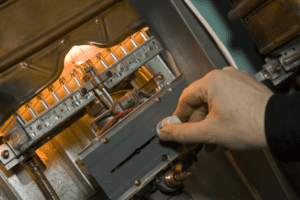From the high-rise office tower to the tiny café on the corner, businesses of all shapes and sizes face many of the same needs. Of these, climate control is one of the most critical, especially in the winter when indoor heating is essential for occupant comfort. Across these diverse industries, the natural gas furnace is one of the most common solutions for on-demand central heating. Though we may take it for granted, commercial heating options as we know them today are the result of many centuries of innovation and the work of many. So, who invented the gas furnace that your business relies upon every winter? Let’s untangle the answer.
Tracing the Early History of Who Invented the Gas Furnace
 Think about the typical furnace, and it doesn’t take much to see that there are many components that engineers needed to invent before the whole package could come together. The blower fan, the thermostat, the combustion chamber, and heat exchangers — no one person created all these items at once and put them together. Although a great deal of work on centralized indoor heating took place over hundreds of years, most of the advances that led to the development of the gas furnaces used by companies today took place in the 19th and 20th centuries.
Think about the typical furnace, and it doesn’t take much to see that there are many components that engineers needed to invent before the whole package could come together. The blower fan, the thermostat, the combustion chamber, and heat exchangers — no one person created all these items at once and put them together. Although a great deal of work on centralized indoor heating took place over hundreds of years, most of the advances that led to the development of the gas furnaces used by companies today took place in the 19th and 20th centuries.
One of the first systems that we would recognize as central heating, and which played an essential role in pushing the field forward, was found in the Massachusetts Medical College. A type of “gravity furnace,” air from outside was pulled into a furnace burning coal, and the warm air allowed to rise naturally through pipes into the rooms of the building. Perhaps the earliest commercial furnace, these types of installations proliferated through the 19th century. Until the advent of electricity, there was no reliable way to blow the air throughout a structure.
By the 20th century, natural gas supply lines were more widespread, and more businesses relied on gas to power furnaces. It wasn’t until groundwork laid by patents held by a woman named Alice Parker, however, that the next generation of commercial heating technology would emerge. Parker is most commonly given as the person who invented the gas furnace since her designs brought together all the main elements: an electric blower, ducting throughout the structure, and a gas-fired furnace.
This concept ultimately led to the implementation of the first blower-driven commercial furnaces in the 1930s, although they would not become widespread until the postwar economic boom. It would take some time before these technologies entered the residential market. Large-scale indoor heating was, for most of its early history, geared towards commercial operators.
The Development of Commercial Heating as We Know It Today
The basic design of the gas furnace has not changed much in the intervening years. However, that does not mean the industry is stagnant; far from it. Commercial HVAC users face a multitude of interlinked concerns, from how to make a business more environmentally friendly to driving down expenditures on energy. Heating costs can represent a large chunk of a company’s basic expenses, and the industry continually strives to identify new ways to make existing technologies more efficient. Since the gas furnace’s invention, some of the most significant advances have included:
- The electric pilot light. Pilot lights in older furnaces were small, ever-present flames used to ignite the main combustion chamber. They were prone to problems and required a constant flow of gas. Today, electronically-generated sparks controlled by the thermostat replace this outmoded technology.
- Variable speed motors. With more heating zones in larger commercial buildings, the ability to vary the temperature to match different requirements is essential. Motors that can vary in speed can help to fine-tune temperatures across a large building.
- High efficiencies. A well-maintained commercial furnace can achieve efficiencies better than 90%, ensuring a better return on your equipment investment. The generally lower cost of natural gas versus electricity makes it an especially appealing choice for businesses with consistent heating needs.
The major furnace manufacturers continue to push the technology further, too, with more advances in efficiency and operational design yet to hit the market.
Looking Towards the Future of Commercial Heating
The furnace has a storied history, from the earliest ideas about forced air heating to the development of modern, ultra-efficient units suitable for even the largest commercial buildings. It should be easy to see that the question of who invented the gas furnace has no singular answer — it is the cumulative effort of many scientists, engineers, and inventors over the years. If you think it’s time for your business to consider a furnace replacement or upgrade, choose a trusted HVAC contractor in your area and seek to take advantage of the latest developments.

